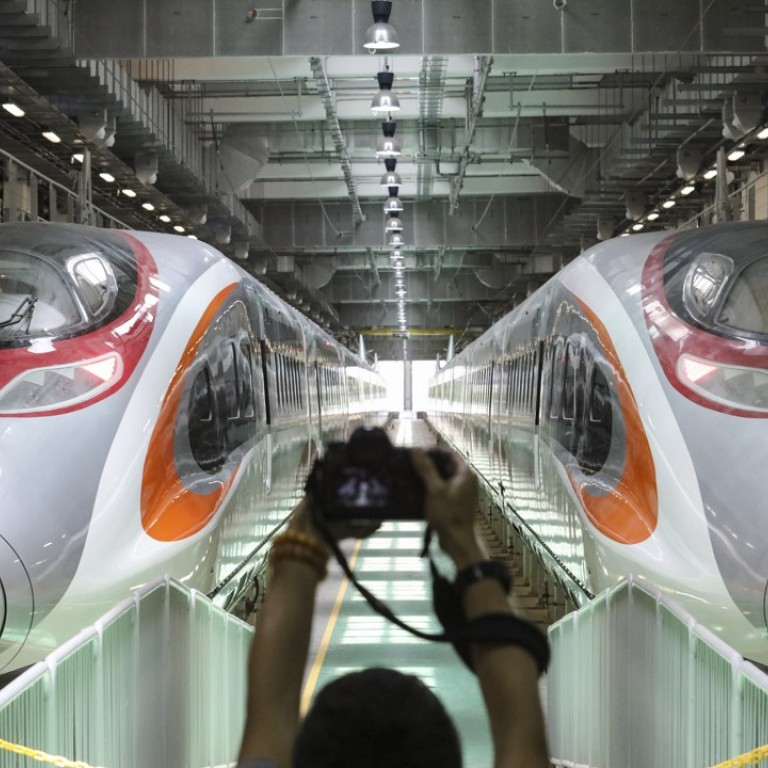
Lease deal likely to end stand-off over joint immigration checkpoint for rail link from Hong Kong to mainland China
Plan for mainland law enforcers to help man joint checkpoint set to be announced next week
Hong Kong is expected to lease space inside the future high-speed rail terminus at West Kowloon to mainland Chinese authorities to implement a plan for a joint immigration checkpoint, under a deal to be announced as early as next week.
The proposal will likely see mainland laws enforced on Hong Kong soil within the leased area, where mainland border control facilities will be installed, according to two lawmakers familiar with the arrangement.
Mainland officers would man the facilities and Hong Kong law enforcers would only venture into the area in the case of an emergency such as an accident or fire.
Legislator Michael Tien Puk-sun, a local deputy to the National People’s Congress, the nation’s top legislative body, said he was aware of the arrangement and did not expect significant resistance from the public to the plan.
“It is the easiest way to implement co-location [of immigration checkpoints],” Tien said. “But it will be important for the NPC Standing Committee to make a decision to declare that such an arrangement does not breach Hong Kong law. This should expel public fears or any possible legal trouble in the future.”
Fellow pro-government lawmaker Priscilla Leung Mei-fun said she had also learned of the arrangement and hailed it as “the best deal” for travellers.
The Executive Council, an advisory body to Hong Kong leader Carrie Lam Cheng Yuet-ngor, is scheduled to be briefed on the details on Monday, and the arrangement will be announced as early as the following day after the formal approval of the council is given at its regular meeting.
“I can only tell you that it will be [ready] pretty soon,” Lam said on Thursday, declining to comment on the reported arrangement. “We will probably have to start the public consultation and discussions, as well as the local legislation work, very soon.”
A bill on setting up a mainland port area inside the rail station is expected to be tabled to Hong Kong’s legislature in October, with the aim of having it passed by early next year.
The bill will provide for the application of mainland laws to the designated area, as well as specify the arrangements that will allow mainland customs and immigration facilities to be co-located with those for Hong Kong at the terminal.
It will be administered as a restricted area according to mainland laws, as is the case at other land border control points between Hong Kong and the mainland.
Pan-democratic lawmakers in the Legislative Council fear mainland laws being enforced in Hong Kong would set a dangerous precedent and that Hongkongers’ rights might be infringed upon. They point to activities allowed under Hong Kong law which are deemed illegal under mainland law, such as “provoking quarrels and making trouble”.
Democratic Party chairman Wu Chi-wai warned that such co-location arrangements could be unconstitutional and subject to legal challenges.

Article 18 of the Basic Law – Hong Kong’s mini-constitution – states that national laws shall not be applied in Hong Kong except for those “outside the limits of the autonomy of [Hong Kong]”. Article 22 states that offices set up by mainland authorities in Hong Kong and the personnel of these offices shall abide by Hong Kong laws.
Chief Secretary Matthew Cheung Kin-chung said on Thursday that the arrangement would conform with the Basic Law.
“We understand the public’s concerns on the matter,” he said. “The arrangement will be able to respond to those concerns. But please do not politicise the issue of co-location. It is just a customs arrangement that will take the transport arrangements between Hong Kong and the mainland to a new level.”
The West Kowloon station arrangement will be similar to that for the existing Shenzhen Bay port.
Hong Kong and Shenzhen struck a deal in 2007 to implement a joint checkpoint arrangement there – the first of its kind.


